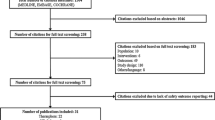Abstract
Introduction
A root cause analysis was performed on the occurrence of gastroduodenal ulceration after hepatic radioembolization (RE). We aimed to identify the risk factors in the treated population and to determine the specific mechanism of nontarget RE in individual cases.
Methods
The records of 247 consecutive patients treated with yttrium-90 RE for primary (n = 90) or metastatic (n = 157) liver cancer using either resin (n = 181) or glass (n = 66) microspheres were reviewed. All patients who developed a biopsy-proven microsphere-induced gastroduodenal ulcer were identified. Univariate and multivariate analyses were performed on baseline parameters and procedural data to determine possible risk factors in the total population. Individual cases were analyzed to ascertain the specific cause, including identification of the culprit vessel(s) leading to extrahepatic deposition of the microspheres.
Results
Eight patients (3.2 %) developed a gastroduodenal ulcer. Stasis during injection was the strongest independent risk factor (p = 0.004), followed by distal origin of the gastroduodenal artery (p = 0.004), young age (p = 0.040), and proximal injection of the microspheres (p = 0.043). Prolonged administrations, pain during administration, whole liver treatment, and use of resin microspheres also showed interrelated trends in multivariate analysis. Retrospective review of intraprocedural and postprocedural imaging showed a probable or possible culprit vessel, each a tiny complex collateral vessel, in seven patients.
Conclusion
Proximal administrations and those resulting in stasis of flow presented increased risk for gastroduodenal ulceration. Patients who had undergone bevacizumab therapy were at high risk for developing stasis.






Similar content being viewed by others
References
Bilbao JI, de Martino A, de Luis E et al (2009) Biocompatibility, inflammatory response, and recannalization characteristics of nonradioactive resin microspheres: histological findings. Cardiovasc Intervent Radiol 32:727–736
Murthy R, Brown DB, Salem R et al (2007) Gastrointestinal complications associated with hepatic arterial yttrium-90 microsphere therapy. J Vasc Interv Radiol 18:553–561
Ogawa F, Mino-Kenudson M, Shimizu M et al (2008) Gastroduodenitis associated with yttrium 90-microsphere selective internal radiation: an iatrogenic complication in need of recognition. Arch Pathol Lab Med 132:1734–1738
Carretero C, Munoz-Navas M, Betes M et al (2007) Gastroduodenal injury after radioembolization of hepatic tumours. Am J Gastroenterol 102:1216–1220
Naymagon S, Warner RR, Patel K et al (2010) Gastroduodenal ulceration associated with radioembolization for the treatment of hepatic tumours: an institutional experience and review of the literature. Dig Dis Sci 55:2450–2458
Kennedy AS, Coldwell D, Nutting C et al (2006) Resin 90Y-microsphere brachytherapy for unresectable colorectal liver metastases: modern USA experience. Int J Radiat Oncol Biol Physiol 65:412–425
Coldwell D, Sangro B, Wasan H et al (2011) General selection criteria of patients for radioembolization of liver tumours: an international working group report. Am J Clin Oncol 34:337–341
Dezarn WA, Cessna JT, DeWerd LA et al (2011) Recommendations of the American Association of Physicists in Medicine on dosimetry, imaging, and quality assurance procedures for 90Y microsphere brachytherapy in the treatment of hepatic malignancies. Med Phys 38:4824–4845
Kennedy A, Nag S, Salem R et al (2007) Recommendations for radioembolization of hepatic malignancies using yttrium-90 microsphere brachytherapy: a consensus panel report from the radioembolization brachytherapy oncology consortium. Int J Radiat Oncol Biol Phys 68:13–23
Lewandowski RJ, Sato KT, Atassi B et al (2007) Radioembolization with 90Y microspheres: angiographic and technical considerations. Cardiovasc Intervent Radiol 30:571–592
Salem R, Lewandowski RJ, Gates VL et al (2011) Research reporting standards for radioembolization of hepatic malignancies. J Vasc Interv Radiol 22:265–278
Louie JD, Kothary N, Kuo WT et al (2009) Incorporating cone-beam CT into the treatment planning for yttrium-90 radioembolization. J Vasc Interv Radiol 20:606–613
Meer AB, Louie JD, Abdelmaksoud MH et al (2011) Intrahepatic collateral supply to the previously embolized right gastric artery: a potential pitfall for nontarget radioembolization. J Vasc Interv Radiol 22:575–577
Abdelmaksoud MH, Hwang GL, Louie JD et al (2010) Development of new hepaticoenteric collateral pathways after hepatic arterial skeletonization in preparation for yttrium-90 radioembolization. J Vasc Interv Radiol 21:1385–1395
Northover JM, Terblanche J (1979) A new look at the arterial supply of the bile duct in man and its surgical implications. Br J Surg 66:379–384
Sjoquist KM, Goldstein D, Bester L (2010) A serious complication of selected internal radiation therapy: case report and literature review. Oncologist 15:830–835
South CD, Meyer MM, Meis G et al (2008) Yttrium-90 microsphere induced gastrointestinal tract ulceration. World J Surg Oncol 6:93
Thamboo TP, Wai CT, Lim LG, Wang SC (2008) Late gastric ulceration and cytomegalovirus infection following selective internal radiation therapy (SIRT) of the liver. Pathology 40:303–305
Parke WW, Michels NA, Ghosh GM (1963) Blood supply of the common bile duct. Surg Gynecol Obstet 117:47–55
Barentsz MW, Vente MA, Lam MG et al (2011) Technical solutions to ensure safe yttrium-90 radioembolization in patients with initial extrahepatic deposition of (99m)technetium-albumin macroaggregates. Cardiovasc Intervent Radiol 34:1074–1079
Hill S, Amesur NB, Zajko AB et al (2012) Reconsidering the necessity for prophylactic embolization of the gastroduodenal artery and right gastric artery prior to radioembolization of the liver with Yttrium-90 microspheres. J Vasc Intervent Radiol 23:S160
Bilbao JI, Garrastachu P, Herraiz MJ et al (2010) Safety and efficacy assessment of flow redistribution by occlusion of intrahepatic vessels prior to radioembolization in the treatment of liver tumours. Cardiovasc Intervent Radiol 33:523–531
Acknowledgments
We thank Jarrett Rosenberg for support with the statistical analysis of the presented data and David Bingham for providing us with an illustration on biopsy histology.
Conflict-of-interest statement
Daniel Sze is on the medical or scientific advisory boards for Surefire Medical, Inc., Treus Medical, Inc., RadGuard Medical, Inc., and Jennerex Biotherapeutics, Inc.; on speaker’s bureau for W. L. Gore, Inc.; and is a consultant for Biocompatibles, Inc. and Sirtex, Inc.
Author information
Authors and Affiliations
Corresponding author
Rights and permissions
About this article
Cite this article
Lam, M.G.E.H., Banerjee, S., Louie, J.D. et al. Root Cause Analysis of Gastroduodenal Ulceration After Yttrium-90 Radioembolization. Cardiovasc Intervent Radiol 36, 1536–1547 (2013). https://doi.org/10.1007/s00270-013-0579-1
Received:
Accepted:
Published:
Issue Date:
DOI: https://doi.org/10.1007/s00270-013-0579-1




